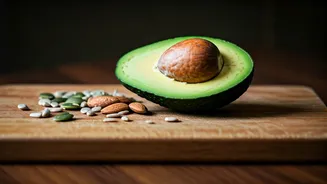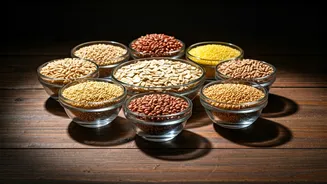Embrace a Change
The journey to effective diabetes management often starts with what you eat. Choosing the right grains can make a significant difference in regulating
blood sugar and supporting weight control. The right grains can assist in managing glucose levels and making weight control easier. By incorporating these into your meals, you're taking a proactive step toward improved health. This transformation is about embracing a lifestyle that not only controls diabetes but also ensures overall well-being. It is about making informed choices that empower you to live a fulfilling life. The grains mentioned in this article are a stepping stone towards a healthier you.
Whole Grains Defined
Whole grains are an essential aspect of a diabetic-friendly diet. Unlike refined grains, whole grains contain the entire grain kernel—the bran, germ, and endosperm. This provides a rich source of fiber, vitamins, and minerals that regulate blood sugar levels. This is the main differentiating factor between processed and unprocessed grains. This fiber helps in slowing down the digestion process, preventing rapid spikes in blood glucose after meals. Including whole grains in your daily diet is a strategic move, offering nutritional benefits and promoting sustained energy levels. The key is in their ability to offer a steady release of energy and essential nutrients.
Barley's Blood Benefits
Barley is a powerhouse grain, especially beneficial for those with diabetes. It's high in soluble fiber, which forms a gel-like substance in the digestive system. This slows down the absorption of sugar, preventing the rapid spikes in blood glucose levels. Barley can be easily integrated into your diet, offering versatility in cooking. Whether added to soups, salads, or used as a side dish, barley provides a nutritional boost. Its low glycemic index makes it a superior option compared to refined grains. Its regular consumption helps in improving insulin sensitivity.
Oats and Glucose
Oats, particularly the whole-grain variety, are celebrated for their ability to manage blood sugar. Similar to barley, oats are packed with soluble fiber, especially beta-glucan. This fiber slows down glucose absorption and improves insulin response. Incorporating oats into breakfast is a smart choice. Oatmeal can keep you feeling full for a longer duration, controlling overeating and maintaining steady blood sugar. Experimenting with different oat preparations is simple. It can be made with water, or with milk. With additions like berries and nuts, it creates a satisfying and health-conscious meal. Oats are considered an excellent dietary choice for individuals looking to control their blood sugar levels.
Quinoa's Advantages
Quinoa is a nutritional champion, and an excellent choice for individuals managing diabetes. It is a complete protein source, offering all nine essential amino acids. With a low glycemic index, quinoa does not cause significant blood sugar spikes. It’s also rich in fiber, further contributing to stable glucose levels. Quinoa is highly versatile in the kitchen. It can be used as a substitute for rice, in salads, or as a base for various dishes. Due to its nutritional profile, quinoa is a valuable part of a balanced diet for overall health. It is a powerhouse of essential vitamins and minerals.
Brown Rice Explained
Brown rice is a better option when compared to white rice, due to its higher fiber content and lower glycemic index. Brown rice contains the whole grain, including the bran and germ, which provide vital nutrients and slow down the release of glucose. Choosing brown rice is a practical way to manage blood sugar levels. It can be a direct substitute for white rice in most meals. It provides a filling base for your favorite dishes while offering health benefits. The inclusion of brown rice will contribute to improved blood glucose control and support better overall health.
Amaranth for Diabetes
Amaranth is an ancient grain that has gained popularity for its nutritional benefits, including its suitability for individuals with diabetes. Amaranth is packed with fiber and protein, contributing to a lower glycemic response. This means it has a minimal impact on blood sugar levels. This ancient grain is also gluten-free. It can be incorporated into your diet in various forms, like porridge or ground into flour for baking. Amaranth provides a wealth of essential nutrients and supports stable blood sugar levels. This grain has the potential to enhance your dietary choices and promote overall wellness.
Millet's Role
Millets are a diverse group of grains, like pearl millet and finger millet, that are incredibly beneficial for managing diabetes. Millets have a low glycemic index, which helps prevent sharp spikes in blood sugar. They also offer a good source of fiber, helping in slower digestion and promoting better glucose control. Millets can be prepared and eaten like rice or used in porridges, offering a range of culinary options. Incorporating millets into your diet is a good approach to support stable blood sugar levels and enhance nutritional intake. These grains are easily adaptable to different cuisines and dietary preferences.
Spelt and Blood Sugar
Spelt, an ancient grain related to wheat, can be a favorable choice for those monitoring their blood sugar. It has a moderate glycemic index and contains a good amount of fiber. This can help with the controlled release of glucose into the bloodstream. Spelt can be used in place of wheat in a variety of dishes. It is a good choice for people trying to improve their dietary habits. When consumed in moderation, spelt can be part of a balanced diet. It can assist in better blood sugar management and general health.
Buckwheat's Benefits
Despite its name, buckwheat is not a type of wheat but is a seed that is gluten-free. Buckwheat is a good option for individuals with diabetes due to its low glycemic index and high fiber content. Buckwheat’s fiber content also contributes to more balanced blood sugar levels. Buckwheat can be used in many recipes. These include pancakes and noodles, which provide nutritious options. Its unique properties and nutritional profile make buckwheat an excellent choice. It’s ideal for people seeking to manage their blood sugar and boost their overall diet.















